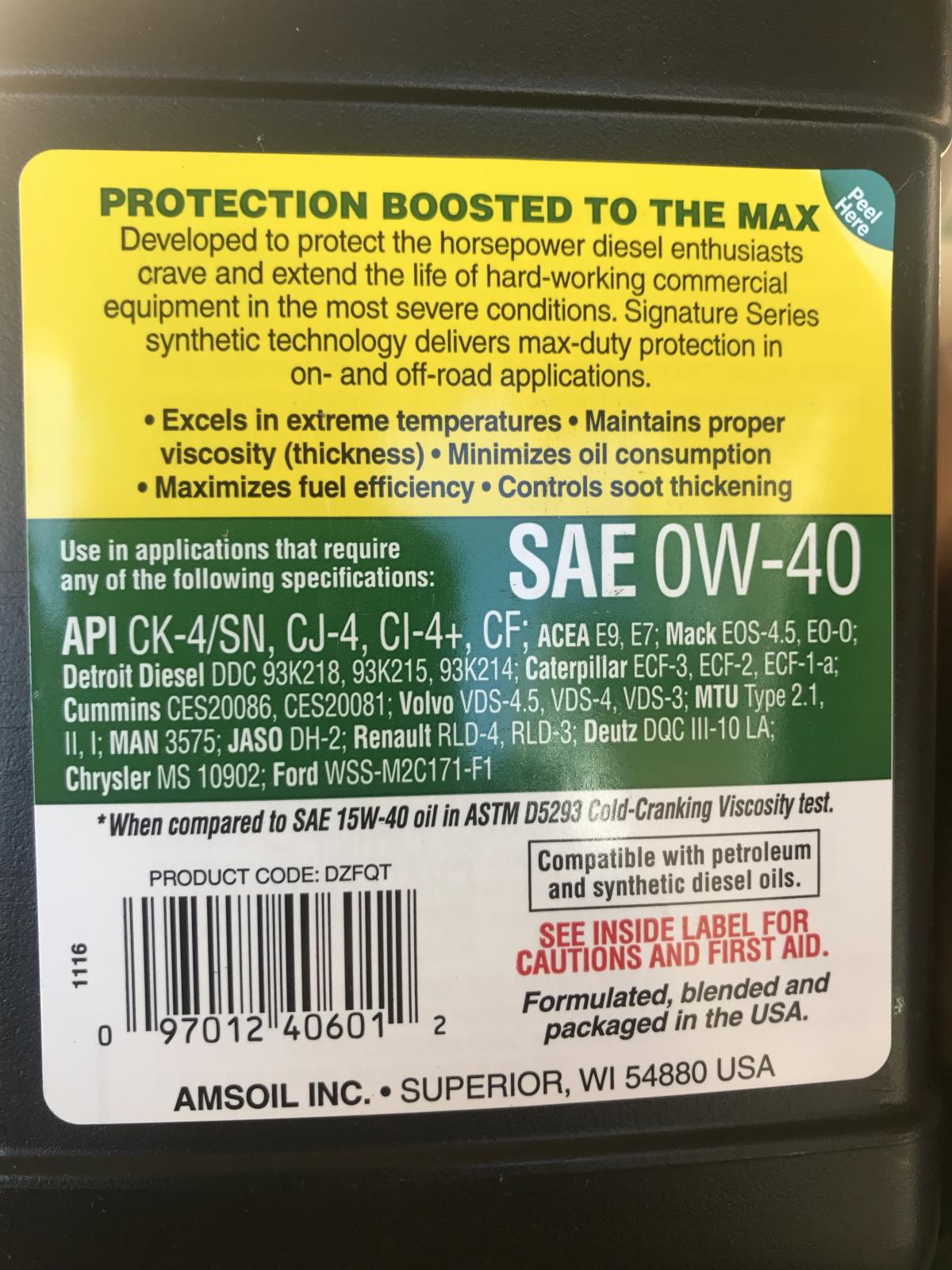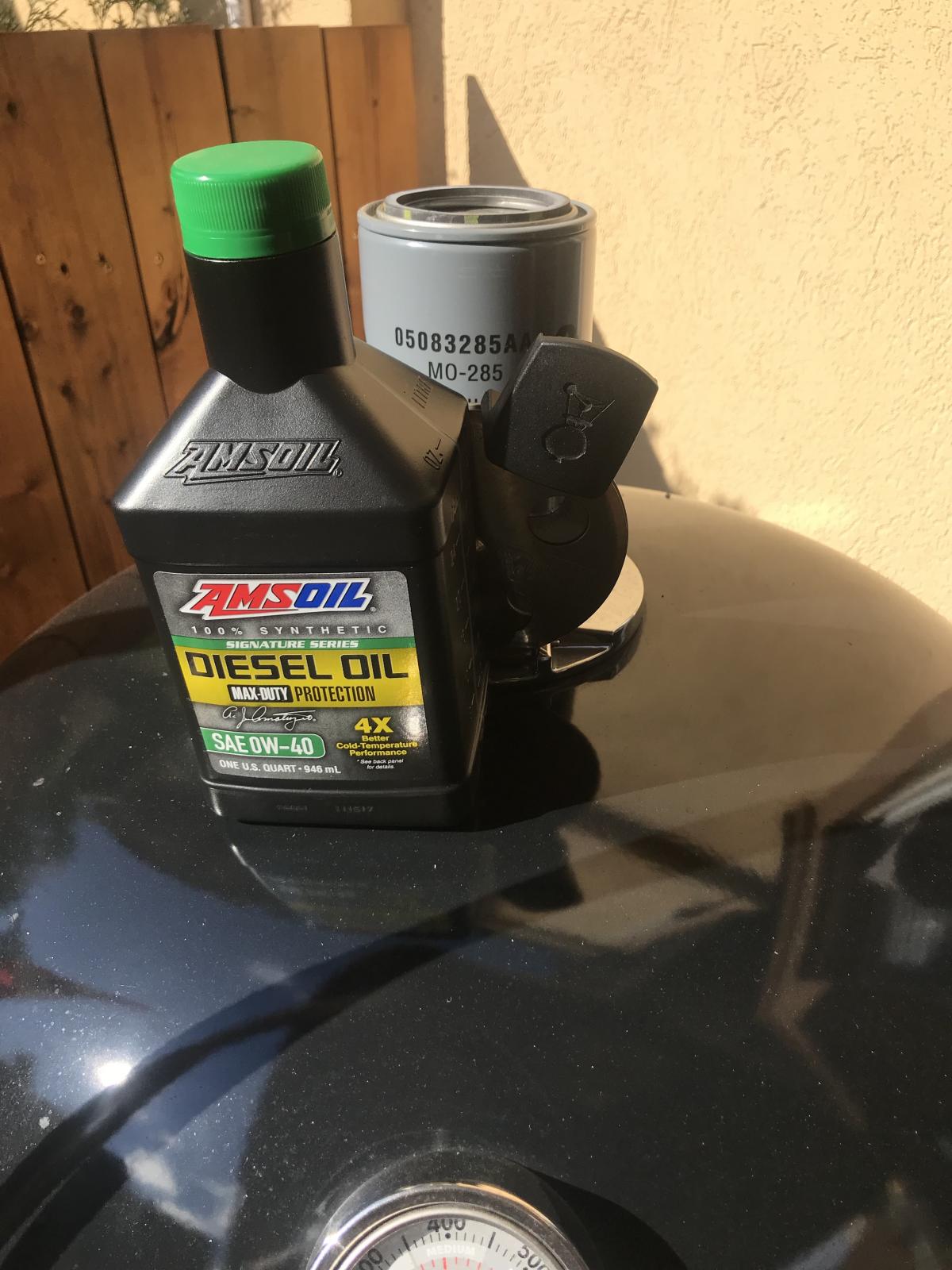Everything posted by ofelas
-
Voltage regulator
Run a dedicated ground from the VR to the firewall, assuming your existing battery/frame/body grounds are good. Also check the ground from the alternator to the front of the block.
-
Wastegate spring?
I like spring gate actuators on compounds. The canister style waste gate actuator is always fighting boost pressure vs drive pressure, sometimes causing waste gate pucks to flutter. The spring gate seems to negate half of the above equation, and in my case, gives me a more linear waste gate opening, particularly noticeable when mashing the pedal on icy highway on ramps.
-
Oil changes
Good stuff AH64ID Any particular reason you're going from AME to the very similar spec'd DME, aside from curiosity? Mopar1973man, I wish I'd known about your situation earlier. I would have sent you an Amsoil bypass setup that I just haven't bothered using these past couple years, but i installed it on my nephew's truck a couple months back.
-
Oil changes
My taxes are double of most folks I know, so I'm resigned to paying double for most things ;-)
-
Oil changes
That is an excellent idea on using mineral oil for moon trips. I'm not sure how well any oil pumps in those low temps though. However, in planet canada, prices are somewhat higher than on the moon. A gallon jug of Rotella costs US$40, while a gallon jug of better spec'd Amsoil is US$38 delivered to my door.
-
Oil changes
Noted. The ~10 NOACK doesn't bother me as much as it should, as I'm ok with makeup oil if needed. I use about a pint of HDD between annual oil changes; never bothered topping it up as it happens during the last month or so of my annual usage. So I dumped in 3 gallons of DZF 0w40 last week, along with a new filter. Right off the bat it cranks similarly to the 5w30 HDD, so winter cranking should be very similar. Whats interesting is the low -54f pour point of the 0w40, while having the highest 212f hot viscosity out of any of their new CK4 Signature Series oils, including the DME 15w40, and HTHS is an AME-like 4.2. Oh yeah - ZDDP comes in at 1206 Phos, 1314 Zinc, and 99 Boron, and I was informed that shearing of VIIs is irrelevant in the DZF formulation - seems like a nice well rounded package.
-
Oil changes
I was literally about to hit the button on AME when I saw your post. That DZF 0w40 has me curious. Wonder how CK4 would do on an old 12v that's happy with CI4+ Just a single full flow filter here; my UOAs weren't appreciably different with EaO80/Donaldson vs the plain old Mopar MO-285, but I change once a year regardless; approx 10k miles a year, not overly concerned with TBN either, Amsoil's way overkill for me but hey...:-) Wonder what kind of Zinc CK4 has in the DZF multi vitamin flavor & how well it'd do with over fueling; I'm liking that "low for a 40wt" 4.2 HTHS.
-
Oil changes
Morning! The UOA I posted is on an early 12v. HDD certainly doesn't look good in your truck, the wear metals are oddly high. I see Copper increased from 14 on your first HDD sample, to over 500 in 10k miles with AME, was there a mechanical issue here? Still at 95 before the rebuild, which I believe is indicative of a tired engine, rather than an oil issue. The high iron...well, typical of Amsoil, not anything I'd concern myself about on a fresh engine if I saw that. The numbers look good after the rebuild, which isn't necessarily the choice of oil. Still, if it's doing good on AME, I see why you're sticking with it. I see before the rebuild, you had some soot thickening up the AME, but in your recent samples, much better. Thats quite a drop in used AME viscosity though, compared to fresh AME. Looks like AME is on the lighter end of a 40w, which I like. Will try it for my annual fill when I change oil/filter over Thanksgiving. I've been super happy with HDD's results as you can see from my UOA posted above, but AME may be a bit of extra protection against any potential overfueling/short tripping. All a moot point, really, as I tend to hit the Webasto for a while in winter; a 70w oil would likely be just fine ;-) As far as oil pressure - at 800rpm hot idle, in about 90f ambient, oil temp at 230f, the HDD is right at 25psi. The fill of AMO 3 yrs back was 30psi or so under similar conditions. Thanks for the charts you posted above.
-
Oil changes
Understood. Still interested in your HDD vs AME UOAs.
-
Oil changes
Well, nice edit. Here's part of your original reply - "he viscosity of your sample is even lower than I ever saw as well. " HDD's virgin viscosity is 11.70, and you find my 11.59 viscosity after 5100 miles "the lowest you've seen" ? Thats laughable. You do realize soot (as opposed to fuel dilution) THICKENS viscosity, right? I understand your liking AME as you don't see cold temperatures, but for some of us that do, we like a thinner oil that is rated to a much lower temperature, and still provide outstanding high temperature protection. I'm sure I don't need too school you in the greater benefits of HTHS as opposed to 212f viscosity. I'd still like to see your comparative oil analyses between AME & HDD, wear metals and all.
-
Oil changes
I'm curious as to why you weren't happy with the HDD UOA's, would be great if you would post the best & worst UOAs with HDD that you had, along with equivalent AME results. Here're mine - the truck was overfueled somewhere between stock & what it is now - OIL USED: AMSOIL 5W-30 HDD MILES ON SAMPLE: 5122 MILES ON TRUCK: 88484 IRON: 11 CHROMIUM: 1 NICKEL: 0 ALUMINUM: 2 COPPER: 8 LEAD: 5 TIN: 0 CADMIUM: 0 SILICON: 4 SODIUM: 0 POTASSIUM: 2 MOLYBDENUM: 0 BORON: 0 MAGNESIUM: 29 CALCIUM: 3865 PHOSPHORUS: 1234 ZINC: 1508 FUEL: .2% VIS @ 100 C, cSt 11.59 WATER: 0 TBN: 10.42 OXID: 7.0 NITR: 6.0 SOOT: .1%
-
Oil changes
Dieselfuture - Fact or speculation? AH64ID - That rings a dim bell; I believe there was some industry wide CCS value vs pour point shuffle a while back. I run HDD, but no complaints about AME on a barely used second gen. Next - as far as Garret snails - anyone make a drop in for a second gen 12v that you know of?
-
Oil changes
Amsoil AME 15w40 used to state a cold pour point of -44F, the current data sheet now lists it at -36F. Anyone know what's changed in this oil?
-
Thermostat
I believe we are saying the same thing in a slightly different way. It's import to bypass during warmup - the NAPA/Mopar/Stant stat's lack of a bypass disc doesn't prevent the bypass flow - when the stat is closed, the bypass is open, and fulfills it's primary function of circulating a trickle coolant through the head. The engineers should have made the rear freeze plug divert as well, but that's easily fixed. On my setup, I divert the stagnant #5 & #6 coolant to my heater core inlet via a Keating Machine tapped freeze plug insert. When towing, and the stat opens to regulate temperature, the bypass closes - this doesn't really cut down flow through the upper rad hose; I've heat gunned the difference back to back on the same day before & after the stats opened. The tiny bypass doesn't really have a chance at affecting a fully open stat's monster flow that these very stout water pumps facilitate.
-
Thermostat
Never did find a warmer than 180f stat for my 12v first gen, so I swapped in a second gen stat housing and use the appropriate stat. Here ya go - 1st gen 12v - 180f 54mm diameter stat (has a tapered seat bypass & 2 jiggle pins) Cummins p/n 5292738. 2nd gen 12v - 180f 63mm diameter stat (has a disc bypass & no jiggle pins- uses the one way check valve to purge air) Cummins p/n 3928499/Mopar 05014568AA. 2nd gen 24v - 190f 58mm diameter with disc bypass (I initially ground this down to 54mm for my first gen but it's too deep to fit inside the 12v head) Cummins p/n 3946849/Mopar 05015708AC. I use a 63mm NOS Mopar # 3418459 in my second gen stat housing, its 195f, and is identical to the Cummins second gen stat in weight & construction, except that is doesn't have the bypass disc or bypass tapered seat. It's commonly available replacement is NAPA 532090/Stant 13479. I'm not concerned about the bypass function, as its only there to close & prevent flow through the bypass passage when the thermostat is open & provide 100% flow through the rad hoses. The bypass hole is too small to make a difference to cooling flow whether closed or open; its primary function is to ensure a bit of coolant circulation when the thermostat is closed, to help avoid hot spots while warming up.






